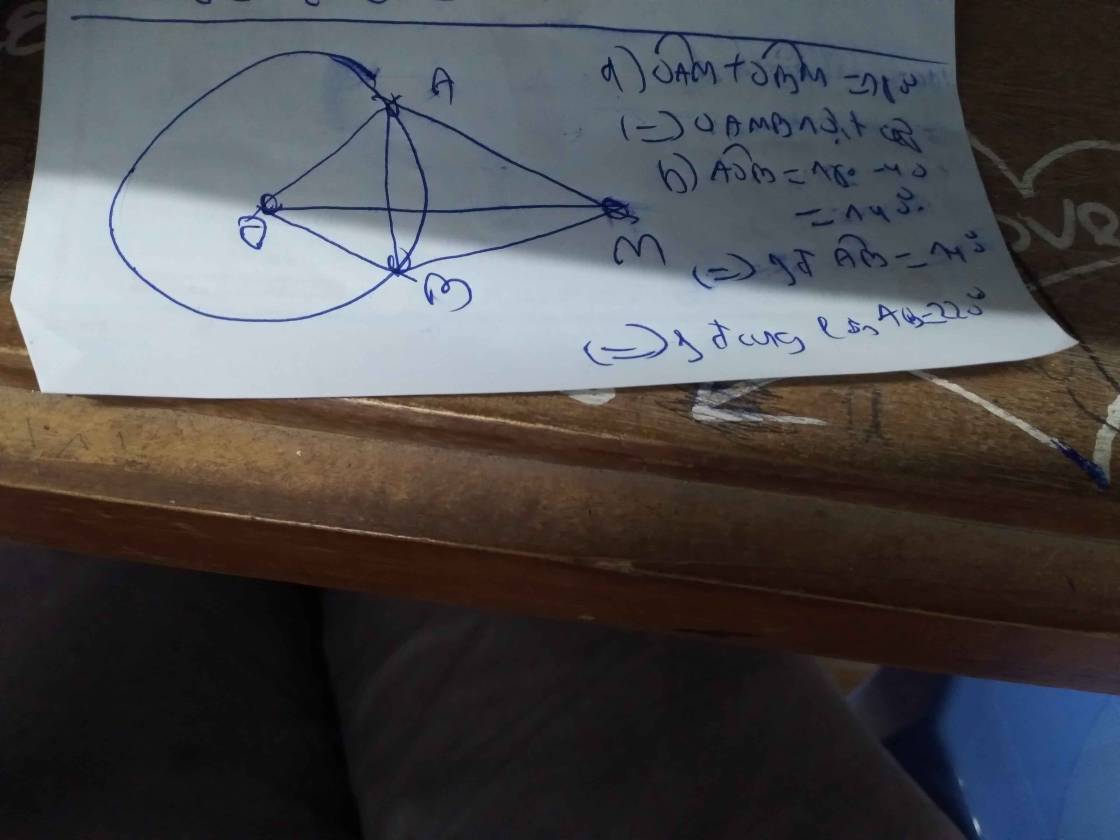
Hãy nhập câu hỏi của bạn vào đây, nếu là tài khoản VIP, bạn sẽ được ưu tiên trả lời.


a: BM là phân giác của góc ABC
=>\(\widehat{ABM}=\widehat{MBC}=\dfrac{\widehat{ABC}}{2}\)
CM là phân giác của góc ACB
=>\(\widehat{ACM}=\widehat{MCB}=\dfrac{\widehat{ACB}}{2}\)
Xét ΔMBC có \(\widehat{MBC}+\widehat{MCB}+\widehat{BMC}=180^0\)
=>\(\widehat{BMC}+\dfrac{\widehat{ABC}+\widehat{ACB}}{2}=180^0\)
=>\(\widehat{BMC}+\dfrac{180^0-\widehat{BAC}}{2}=180^0\)
=>\(\widehat{BMC}+\dfrac{180^0-a}{2}=180^0\)
=>\(\widehat{BMC}=180^0-90^0+\dfrac{a}{2}=\dfrac{a}{2}+90^0\)
Vì BM,BN lần lượt là phân giác trong và phân giác ngoài tại đỉnh B của ΔABC nên BM\(\perp\)BN
=>\(\widehat{MBN}=90^0\)
Vì CM,CN lần lượt là phân giác trong và phân giác ngoài tại đỉnh C của ΔABC nên CM\(\perp\)CN
=>\(\widehat{MCN}=90^0\)
Xét tứ giác BMCN có \(\widehat{BMC}+\widehat{BNC}+\widehat{MBN}+\widehat{MCN}=360^0\)
=>\(\widehat{BNC}+90^0+\dfrac{a}{2}+90^0+90^0=360^0\)
=>\(\widehat{BNC}=90^0-\dfrac{a}{2}\)
b: Xét tứ giác BMCN có \(\widehat{MBN}+\widehat{MCN}=90^0+90^0=180^0\)
nên BMCN là tứ giác nội tiếp đường tròn đường kính MN
=>B,M,C,N cùng thuộc đường tròn tâm O đường kính MN
Tâm O là trung điểm của MN

\(A=\dfrac{\left(sina+cosa\right)\left(sin^2a-sina\cdot cosa+cos^2a\right)}{cosa\cdot sina\left(2cosa+sina\right)}\)
\(=\dfrac{\left(sina+cosa\right)\left(1-sina\cdot cosa\right)}{cosa\cdot sina\left(2\cdot cosa+sina\right)}\)
\(1+tan^2a=\dfrac{1}{cos^2a}=1+\dfrac{9}{25}=\dfrac{34}{25}\)
\(\Leftrightarrow cosa=\dfrac{5}{\sqrt{34}}\)
=>\(sina=\dfrac{3}{\sqrt{34}}\)
\(=\dfrac{\left(sina+cosa\right)\left(1-sina\cdot cosa\right)}{cosa\cdot sina\left(2\cdot cosa+sina\right)}\)
\(=\dfrac{\left[\left(\dfrac{3}{\sqrt{34}}+\dfrac{5}{\sqrt{34}}\right)\left(1-\dfrac{15}{34}\right)\right]}{\dfrac{15}{34}\cdot\left(\dfrac{10}{\sqrt{34}}+\dfrac{3}{\sqrt{34}}\right)}\)
\(=\dfrac{\dfrac{8}{\sqrt{34}}\cdot\dfrac{19}{34}}{\dfrac{15}{34}\cdot\dfrac{13}{\sqrt{34}}}=\dfrac{8\cdot19}{15\cdot13}=\dfrac{152}{195}\)

O A B M I
Gọi I là trung điêm OM
do đó ta có tính chất của trung tuyến ứng với cạnh huyền lầ
\(IO=IA=IM=\frac{1}{2}OM=\frac{1}{2}.2R=R\)
Xét tam giác IOA có \(IO=OA=AI=R\Rightarrow\)tam giác IOA đều nên IOA = 60 độ
chứng minh tương tự ta sẽ có góc IOB=60 độ
nên AOB=AOI+IOB=120 độ

Bài 1:
a) Ta có:
\(tanB=\dfrac{AC}{AB}\Rightarrow\dfrac{AC}{AB}=\dfrac{5}{2}\)
\(\Rightarrow AC=\dfrac{AB\cdot5}{2}=\dfrac{6\cdot5}{2}=15\)
b) Áp dụng Py-ta-go ta có:
\(BC^2=AB^2+AC^2=6^2+15^2=261\)
\(\Rightarrow BC=\sqrt{261}=3\sqrt{29}\)
Bài 2:
\(\left\{{}\begin{matrix}sinM=sin40^o\approx0,64\Rightarrow cosN\approx0,64\\cosM=cos40^o\approx0,77\Rightarrow sinN\approx0,77\\tanM=tan40^o\approx0,84\Rightarrow cotN\approx0,84\\cotM=cot40^o\approx1,19\Rightarrow tanN\approx1,19\end{matrix}\right.\)

Đặt \(tan\alpha=x\Rightarrow cot\alpha=\frac{1}{x}\)
Ta có : \(tan\alpha+cot\alpha=2\)
\(\Leftrightarrow x+\frac{1}{x}=2\)
\(\Leftrightarrow x^2-2x+1=0\)
\(\Leftrightarrow\left(x-1\right)^2=0\)
\(\Leftrightarrow x=1\)
Vậy \(tan\alpha=1\Rightarrow\alpha=45^o\)(thỏa mãn)

bài bày có thể bấm máy tính nhá
A. bấm sin-1( 0.245) sau đó bấm S\(\Leftrightarrow\)D
B. bấm tan-1(4.127) sau đó bấm S\(\Leftrightarrow\)D
kết quả sẽ ra độ hơi lẻ thì làm tròn lại nhé.